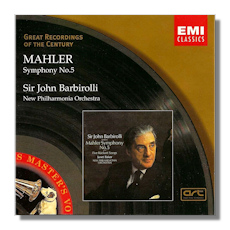
The Internet's Premier Classical Music Source
Related Links
- Mahler Reviews
- Latest Reviews
- More Reviews
-
By Composer
-
Collections
DVD & Blu-ray
Books
Concert Reviews
Articles/Interviews
Software
Audio
Search Amazon
Recommended Links
Site News
 CD Review
CD Review
Gustav Mahler

Symphony #5
- Symphony #5 in C Sharp minor (1901-02)
New Philharmonia Orchestra/John Barbirolli
EMI 66962
Is it possible that Mahler's 5th was the first symphony composed (premièred?) in the 20th Century? Whether it is, in fact, or not… it certainly should have been. Now, I do not cotton with those who find existential angst as a conscious motivating force in Mahler, but the results could certainly imply as much. The bottom line is that in this piece of music I can hear the century we just left behind. Only Shostakovich has a similar impact on me.
I am reading a most excellent biography of Mahler. It is by Jonathan Carr and it captures the feeling of Mahler's era as well as offering insights to his music. For example, when talking about Mahler's stay in New York, Carr just mentions that he and Alma met, and spent some time with, a woman who had spent some time living with "North American Indians" and "a Russian prince who strode about New York with a couple of wolves." These, and other details, help to make the whole era come more alive.
While reading it I have also been listening to his symphonies, especially this particular recording. I have also listened to a recent live performance from Rafael Kubelík and the Symphonie-Orchester des Bayerischen Rundfunks (Audite 95.465). I find it fascinating to compare recordings; each offers different insights to a piece of music. Barbirolli, for example, tends to be a shade darker than Kubelík, evoking images of Mahler's 7th to come. This doesn't mean that Kubelík has nothing to offer, on the contrary. His interpretation is limned more cleanly.
One of the major reasons for the difference is the sound of the two recordings. The EMI recording is deep, rich and the bass has more prominence. There is more reverberation, which I happen to like, but it doesn't obscure detail. The Kubelík is from a live performance in 1981 and the sound initially seems a bit thinner. My ears soon adjusted, however, and the details here, while not really different in fact, are different in perception.
Okay, I am getting really frustrated trying to find the words to tell you how these two interpretations differ. I could point out, too, that Kubelík is faster than Barbirolli by three minutes, but takes a minute longer in the Adagio. All of this seems more and more frustrating. I know what I am hearing and urge readers to get both of these recordings and hear for themselves. Kubelík, Bernstein, Gatti and Chailly also have things to say worth listening to. Barbirolli's recording earned a rosette in the Penguin Guide to Compact Discs and it is certainly arguably the finest.
While writing this I also began to ask myself if there is a "Mahler Sound" or if you could select a symphony that might embody "typical" Mahler. The Fifth certainly could be used as an example. It has all the phantasmagoric, Viennese folk music, soaring melodies, everything but song. If you want to start with a Mahler 5th, the Barbirolli should be where you begin. If you are thinking of adding to your collection, Barbirolli should be in it.
Copyright © 2000, Robert Stumpf II


















